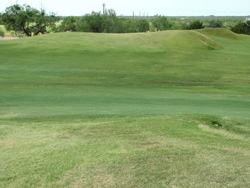Helping A Drought-Stress Turf Survive Winter
Mid August is the point in time where golf course superintendents managing bentgrass greens can begin to see the proverbial light at the end of the tunnel regarding summer stress. This same time period is equally important for those growing bermudagrass on the golf course. It may be hard to believe, but winter bermudatgrass preparations begin right now with the usual activities including:
- Raising the cutting heights.
- Applying potassium.
These practices are very important and should always be done in late August (versus mid-fall) so that the bermudagrass has some growing season left to store carbohydrates.
 |
This year we endure the same unfortunate twist we experienced two years ago - somewhat of a drought condition going into fall. Research has shown over the years that winter damage to bermudagrass is greatly magnified when bermudagrass goes dormant in drought conditions. It is a critical factor for turf managers to understand and appreciate, but it also is an important time to educate the golf course membership if the drought is severe. For golf courses with very limited irrigation water availability or irrigation coverage, some additional steps may be needed to protect the bermudagrass from a severe winter and the greater chance for damage.
Raising the cutting height approximately 1/8" higher than the normal increase in the fairways and tees, and an additional ¼" in the roughs can help improve winter tolerance. Moreover, a slightly increased application of potash can be very helpful. Applying 1 ¼ lb. to 1 ½ lb. potassium per 1000 sq. ft. instead of 1 lb is the recommended rate. In severe drought areas going into fall, removal, or at least significant restriction of, cart traffic also can be great protection for the bermudagrass during the late fall and winter. Different types of cart restrictions to the paths may be based on the severity of the drought. There is no question traffic adds to the damage on bermudagrass during the winter months.
In conjunction with the maintenance changes, this is a critical time for golfer education if more drastic measures have to be taken to protect the bermudagrass should a quality rain not be experienced by late August. The rain is desperately needed to hydrate the bermudagrass rhizomes and roots prior to the onset of fall. Educating the membership now about these possible turf protection programs helps them understand and consequently support the superintendent's efforts much better. In the golfing industry, we know the importance of education, and this is one area where early education of golfers pays off for the future.
We strongly urge you to visit the USGA web site at www.usga.org and click on Supporting the Game tab to learn more about Green Section programs and to stay up-to-date on activities in the Mid-Continent area via our Mid-continent Regional Update, ( http://www.usga.org/turf/regional_updates/regional_updates.html bringing you new information every two weeks.
If you would like more information about a Turf Advisory
Service visit, please contact either of the Mid-Continent
regional offices listed: Bud White, (972) 662-1138 or (
budwhite@usga.org
) and Ty McClellan,
tmcclellan@usga.orgor (630) 340-5853.
